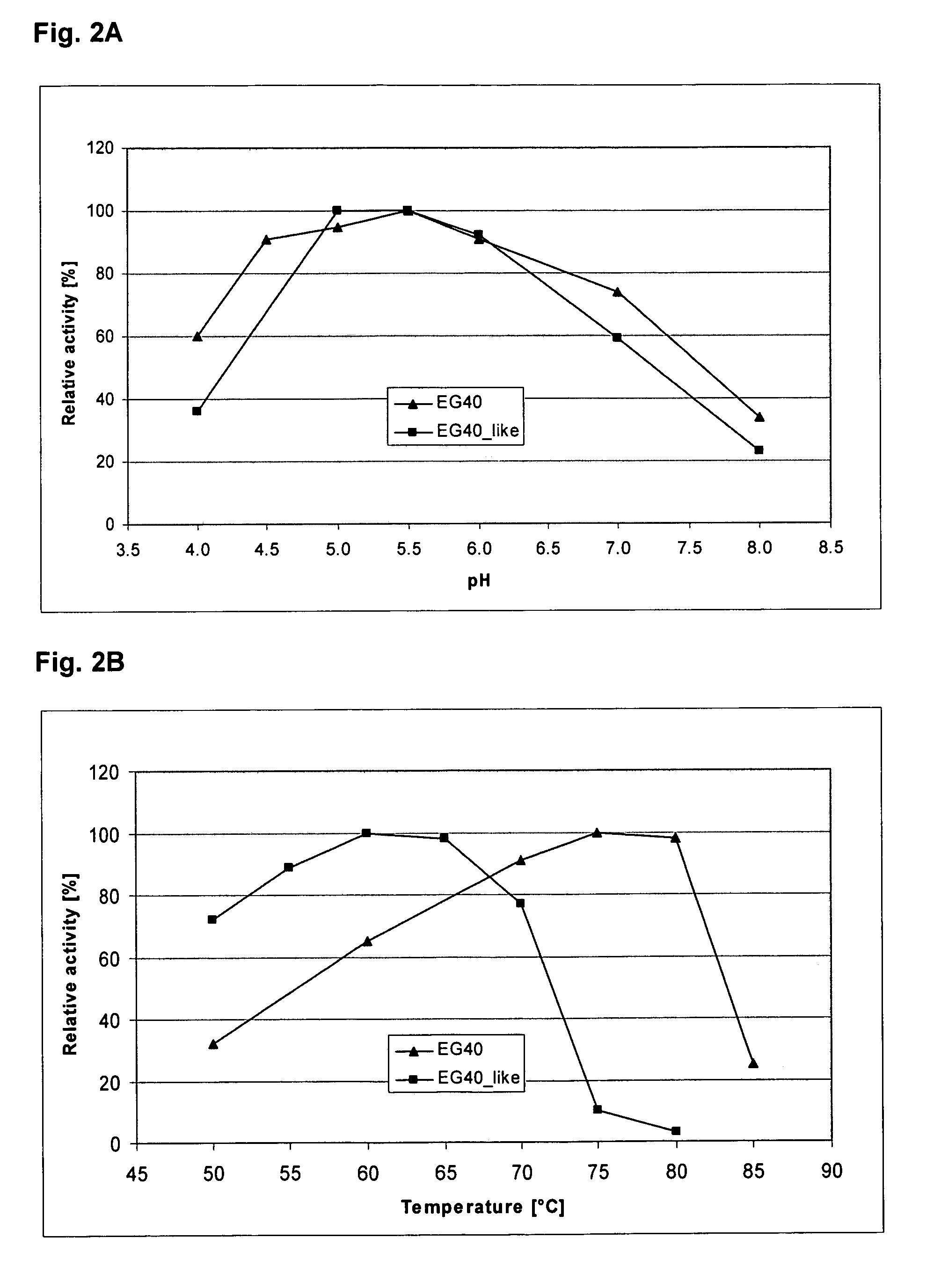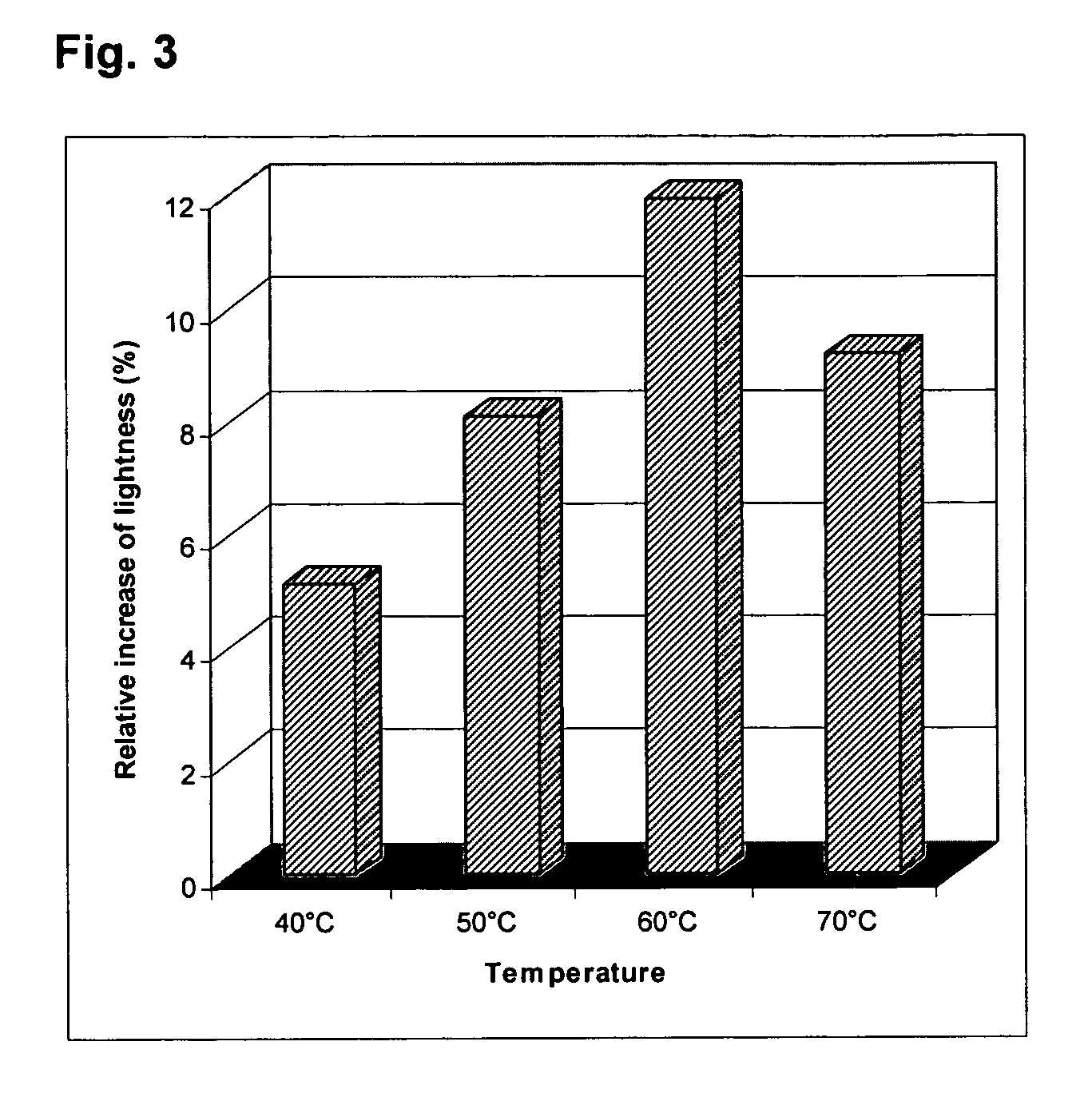Enzymes
a cellulase and enzyme technology, applied in the field of new cellulase enzymes, can solve the problems of reducing the strength of fabrics, burdening the laundering apparatus, and affecting the practical use of cellulases, so as to enhance the performance, stability, or buffer the desired enzyme preparation
- Summary
- Abstract
- Description
- Claims
- Application Information
AI Technical Summary
Benefits of technology
Problems solved by technology
Method used
Image
Examples
example 1
Cultivation of the Acremonium thermophilum ALKO4245
[0116]The Acremonium thermophilum strain ALKO4245 was grown in a 2 liter bioreactor (Braun Biostat® B, Braun, Melsungen, Germany) in the following medium, g / l: Solka Floc cellulose 40, corn steep powder 15, distiller's spent grain 5, oats spelt xylan 3, locust bean gum 3, (NH4)2SO4 5 and KH2PO4 5. The pH range was 5.2±0.2 (NH3 / H2SO4), aeration 1 vvm, stirring 300–600 rpm, antifoam control with Struktol® and the temperature 42° C. The cultivation time was 4 days. After cultivation the cells and other solids were collected by centrifugation and the supernatant was recovered.
example 2
Purification of an endoglucanase from Acremonium thermophilum ALKO4245
[0117]The culture supernatant of Acremonium thermophilum ALKO4245, grown as described in Example 1, was incubated at 70° C. for 24 hours after which it was concentrated by ultrafiltration. The pure endoglucanase was obtained by sequential purification with hydrophobic interaction and cation exchange chromatography followed by gel filtration. The endoglucanase activity of the fractions collected during purification was determined using carboxymethyl cellulose (CMC) as a substrate (according to the procedure of IUPAC, 1987).
[0118]The concentrated culture supernatant was applied to the HiPrep 16 / 10 Butyl FF hydrophobic interaction column (GE Healthcare) equilibrated with 20 mM potassium phosphate buffer, pH 6.0, containing 1 M (NH4)2SO4. Bound proteins were eluted with a linear gradient from the above buffer to 5 mM potassium phosphate, pH 6.0. Fractions were collected and the endoglucanase activity was determined as...
example 3
Cloning of Acremonium thermophilum (ALKO4245) cel45A and cel45B Genes
[0124]Standard molecular biology methods were used in the isolation and enzyme treatments of DNA (plasmids, DNA fragments), in E. coli transformations, etc. The basic methods used are described in the standard molecular biology handbooks, e.g. Sambrook, J., et al., 1989 and Sambrook J. and Russell, D. W., 2001.
[0125]The genomic library of Acremonium thermophilum ALKO4245 was constructed in Lambda DASH®II vector (Stratagene, USA) according to the instructions from the manufacturer. The chromosomal DNA, isolated by the method of Raeder and Broda, 1985, was partially digested with Sau3A. The digested DNA was size-fractionated in an agarose gel and the fragments of chosen size (about 5–23 kb) were isolated, dephosphorylated and ligated to the BamHI digested lambda vector arms. The ligation mixture was packaged using the Gigapack III Gold packaging extracts according to the manufacturer's instructions (Stratagene, USA)....
PUM
| Property | Measurement | Unit |
|---|---|---|
| pH | aaaaa | aaaaa |
| pH | aaaaa | aaaaa |
| temperature | aaaaa | aaaaa |
Abstract
Description
Claims
Application Information
 Login to View More
Login to View More - R&D
- Intellectual Property
- Life Sciences
- Materials
- Tech Scout
- Unparalleled Data Quality
- Higher Quality Content
- 60% Fewer Hallucinations
Browse by: Latest US Patents, China's latest patents, Technical Efficacy Thesaurus, Application Domain, Technology Topic, Popular Technical Reports.
© 2025 PatSnap. All rights reserved.Legal|Privacy policy|Modern Slavery Act Transparency Statement|Sitemap|About US| Contact US: help@patsnap.com



